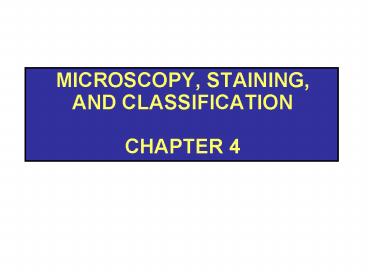Microscopy, Staining, and Classification Chapter 4 - PowerPoint PPT Presentation
1 / 42
Title:
Microscopy, Staining, and Classification Chapter 4
Description:
Differences in intensity between two objects, or ... Contains a single magnifying lens. Similar to magnifying glass ... Magnify objects 10,000X to 100,000X ... – PowerPoint PPT presentation
Number of Views:429
Avg rating:3.0/5.0
Title: Microscopy, Staining, and Classification Chapter 4
1
Microscopy, Staining, and ClassificationChapter
4
2
Microscopy
- General principles of microscopy
- Wavelength of radiation
- Magnification
- Resolution
- Contrast
3
Electromagnetic Spectrum
Figure 4.1
4
Resolution
- Ability to distinguish (resolve) two
close-together points as separate.
5
Contrast
- Differences in intensity between two objects, or
between an object and background - Important in determining resolution
- Staining increases contrast
6
Light Microscopy
- Bright-field microscopes
- Dark-field microscopes
- Phase microscopes
- Fluorescent microscopes
7
Bright-Field Microscopes
- Two types
- Simple
- Compound
- Simple
- Contains a single magnifying lens
- Similar to magnifying glass
- Leeuwenhoek used simple microscope to observe
microorganisms
8
Bright-Field Microscopes
- Compound
- Uses a series of lenses for magnification
- Light rays pass through specimen and into
objective lens (one of a series of objective
lenses) - Oil immersion lens increases resolution because
light does not refract - Has one or two ocular lenses
- Total magnification magnification of objective
lens X magnification of ocular lens
9
Dark-Field Microscopes
- Best for observing pale objects
- Specimen appears light against dark background
- Increases contrast and enables observation of
more details - Good for watching bacterial motion.
10
Phase Microscopes
- Used to examine living organisms or specimens
that would be damaged or altered by attaching
them to slides or staining them - These microscopes treat one set of light rays
differently from another set - Light rays in phase produce brighter image, while
light rays out of phase produce darker image - Contrast is created because light waves are 1/2
wavelength out of phase - Two types
- Phase-contrast microscope
- Differential interference contrast microscope
11
Four Kinds of Light Microscopy
Figure 4.8a
12
Four Kinds of Light Microscopy
Figure 4.8b
13
Four Kinds of Light Microscopy
Figure 4.8c
14
Four Kinds of Light Microscopy
Figure 4.8d
15
Fluorescent Microscopes
- Direct UV light source at specimen causes the
specimen to radiate energy back as a longer,
visible wavelength - UV light increases resolution and contrast
- Some cells and molecules are naturally
fluorescent, while others must be stained - Used in immunofluorescence to identify pathogens
and to locate and make visible a variety of
proteins
16
Immunofluorescence
Figure 4.10a
17
Transmission Electron Microscope
Figure 4.11
18
Electron Microscopy
- Light microscopes cannot resolve structures
closer than 200 nm because shortest wavelength of
visible light is 400 nm - Electrons have wavelengths of 0.01 nm to 0.001
nm, so electron microscopes have greater
resolving power and greater magnification - Magnify objects 10,000X to 100,000X
- Provide detailed views of bacteria, viruses,
internal cellular structures, molecules, and
large atoms - Two types
- Transmission electron microscopes
- Scanning electron microscopes
19
TEM Image
Figure 4.11c
20
SEM Image
Figure 4.13a
21
SEM Image
Figure 4.13b
22
SEM Image
Figure 4.13c
23
SEM Image
Figure 4.13d
24
Staining
- Increases contrast and resolution by coloring
specimens with stains/dyes - Smear of microorganisms (thin film) air dried to
slide and then fixed to surface by heat or
chemical fixation - Microbiological stains are usually salts composed
of cation and anion and one is colored
(chromophore) - Acidic dyes stain alkaline structures basic dyes
stain acidic structures and are used more commonly
25
Staining
- Simple stains
- Differential stains
- Gram stain
- Acid-fast stain
- Endospore stain
- Special stains
- Negative (capsule) stain
- Flagellar stain
- Fluorescent stains
- Staining for electron microscopy
26
Simple Stains
Figure 4.16b
27
Gram Stain
Figure 4.17.1
28
Gram Stain
Figure 4.17.2
29
Gram Stain
Figure 4.17.3
30
Gram Stain
Figure 4.17.4
31
Acid-Fast Stain
Figure 4.18
32
Endospore Stain
Figure 4.19
33
Negative (Capsule) Stain
Figure 4.20
34
Flagellar Stain
Figure 4.21
35
Classification and Identification of
Microorganisms
- Taxonomy consists of classification,
nomenclature, and identification - Enables scientists to organize large amounts of
information about organisms and make predictions
based on knowledge of similar organisms
36
Linnaeus
- Linnaeus provided system that standardized the
naming and classification of organisms based on
characteristics they have in common - Grouped similar organisms that can successfully
interbreed into categories called species - Binomial nomenclature
37
Whitaker
- Linnaeus proposed only two kingdoms
- Whitaker proposed a widely accepted taxonomic
approach based on five kingdoms Animalia,
Plantae, Fungi, Protista, and Prokaryotae
38
Domains
- Carl Woese compared nucleotide sequences of rRNA
subunits (changes occur rarely) - Proposal of three domains based on three basic
types of cells as determined by ribosomal
nucleotide sequences - Eukarya, Bacteria, and Archaea
39
Taxonomic and Identifying Characteristics
- Physical characteristics
- Biochemical tests
- Serological tests
- Phage typing
- Analysis of nucleic acids
40
Taxonomic Keys
- Dichotomous keys series of paired statements
worded so that only one of two either/or
choices applies to any particular organism - Key directs user to another pair of statements,
or provides name of organism
41
Dichotomous Taxonomic Key
Figure 4.28a
42
Dichotomous Taxonomic Key
Figure 4.28b































